Peter Zeidler, who is now the head coach at St. Gallen in Switzerland, and Gerhard Struber, who is since last year the head coach of Barnsley in the EFL Championship, are only two coaches who worked within the last years at FC Liefering, which is the second team of RB Salzburg. Oliver Glasner, who is a head coach in the Bundesliga at Wolfsburg for the first time this season, also worked there as an assistant coach and the likes of Alexander Zickler, Franz Schiemer, and René Aufhauser also worked there as assistant coaches. This already shows us that within the last few years, there had worked several interesting head and assistant coaches who then went on to become successful somewhere else or at RB Salzburg.
The Dane Bo Svensson is the head coach of Liefering since the summer of 2019. Even though we know that they also use the RB philosophy, we will look in this tactical analysis at the tactics and the style of play of Svensson.
Basic overview
It should come as no surprise that Liefering’s tactics employ the basic idea of how to play the RB philosophy which means that they want to attack especially through the centre and have a vertical style of play. We will look at this later in this tactical analysis in more detail, but it also explains at least a bit why Svensson lines his team mostly up in a 4-3-1-2 and a 4-4-2 diamond respectively. There’s no real difference between them but one can call it the one way and others can call it the other one.
The Dane is just 40 years old which is still quite young for a coach, but since Liefering are a kind of second team and the U23s of RB Salzburg, he has only young talents in his squad. Due to that, there is still a huge age gap between the players and the coach. According to Transfermarkt, the average age of Liefering’s 25 players is 18.28. Also, the goalkeeper and captain Daniel Antosch is the only player who is part of the squad since 2017, while all other players got added to the team in 2018, 2019, or 2020. This shows us that this is, for the majority of the players, the station between the youth teams of Salzburg and the first team.
However, not all players are from the youth academy of Salzburg since they sometimes also bring in young talents from other countries. For example, in the summer of 2019, RB Salzburg bought three 16-year-olds from Switzerland, Slovenia, and Denmark to then loan them to Liefering. Since Svensson’s team are not officially the second squad of RBS, but a so-called cooperation club, they can move players between the clubs as they want.
Next, we will have a closer look at the tactics to see how Svensson lets his young men play on the pitch.
Build-up
Basically, Liefering are rarely the team which really dominates the game (on average 50.2% possession) as they also sit back beside their press to lure out the opposition to have more space for the counter-attacks. When they have the ball, they want to have a clean progression of the ball by using short passes. They stay in their 4-3-1-2 formation and the back four positions wide. So the full-backs hug the touchline while the centre-backs also position a bit wider. The three central midfielders stay in front of them during the first stage to have enough men to always stay in numerical advantage.
Due to that, even when the opposition are pressing in at them, the young talents stay calm and try to use short passes and intelligent movements to support each other and to pass their way free, as we can see in the example below in which the right midfielder, Luka Sučić, supports the right-back, Wallison. After a little interplay between these two, the passing lane towards the left centre-back David Affengruber opens up and Wallison plays the ball over. Affengruber can then easily pass the ball to the left-back to exploit the free space on the other wing.
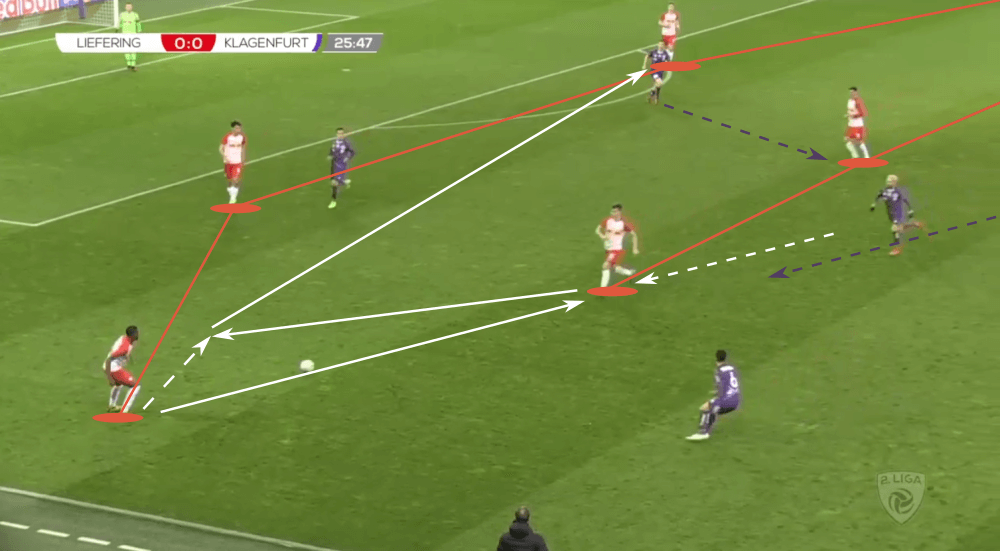
Considering this example above, their calmness is often quite special especially when you remember their average age with 18.28. But, some of them have the potential to play on the highest level in Austria and probably somewhere else too, and they prove that in such moments by staying calm and solving the situation.
As in the example above, they often try to use the free space in front of a centre-back whenever the opposition press in at them on one wing. Mostly it is Affengruber who then wants the ball and tells his teammates to play it to him and he then uses the space in front of him to dribble forward. We can see an additional example for that below.
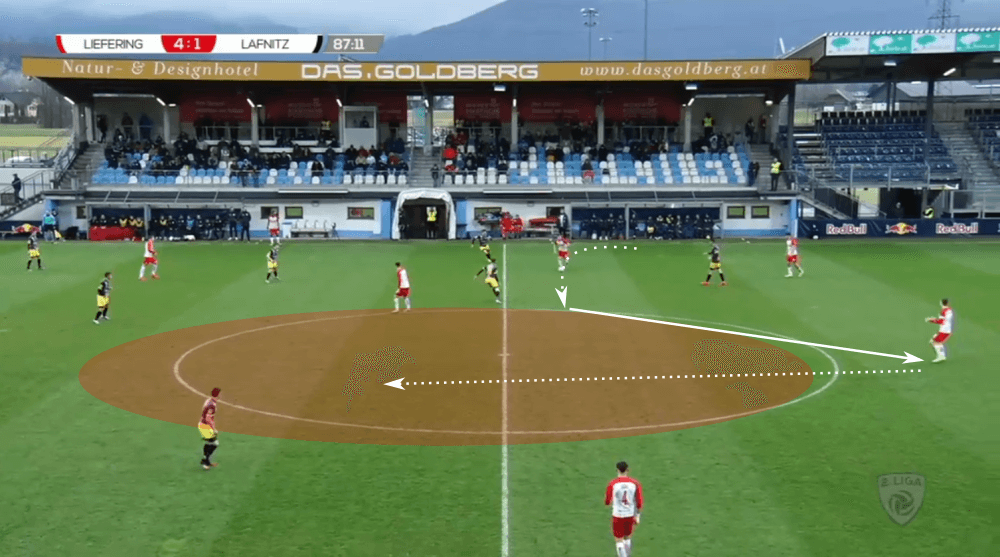

Since there are no real wingers in their system, the progression of the ball mostly goes through the centre. Even though the forwards, the number 10, or one of the outer central midfielders drift sometimes to the outside to stretch the pitch at least a bit, the basic idea is to use vertical and diagonal passes through the centre to break the lines.
To do so, the players are constantly asked to position themselves between the lines of the opposition in free spaces to open up passing lanes towards them. Nicolas Seiwald, Alexander Prass, and Tobias Anselm are three players in particular who are excellent in this. While Seiwald is mostly one of the deeper positioned midfielders, Anselm and Prass usually play in the more advanced positions. However, all three of them always look for free spaces to support their teammates as it can be seen in the shot below when Seiwald is free in the left half-space, receives the ball, and immediately plays it forward to Anselm who also finds a free area between the lines of the opposition.
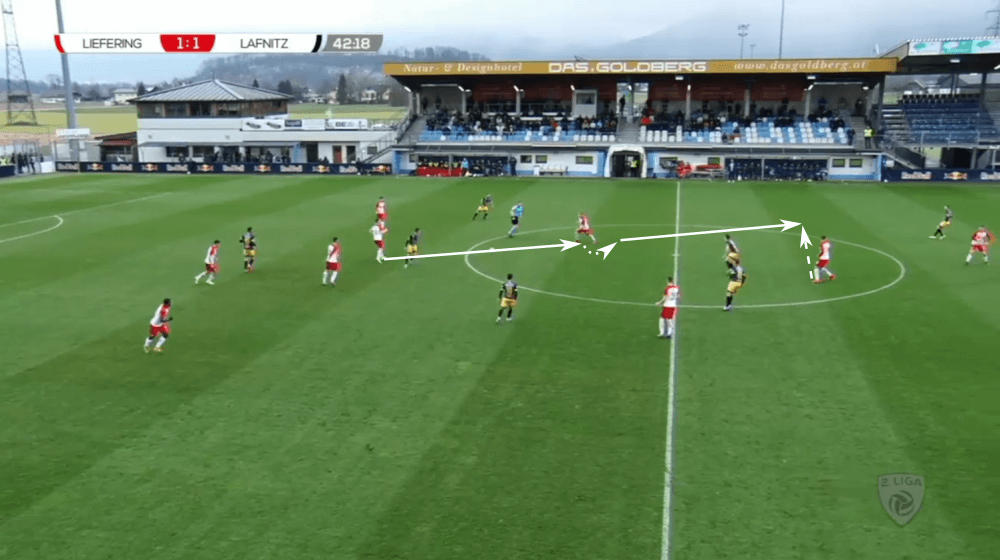
As soon as they then are able to reach the final third, their tactics become very similar to the ones of RB Salzburg as they try to use the combination of short passes and deep runs to come behind the last line of the opposition, enter the penalty box, and create a goalscoring opportunity. The deep runs at this point are especially really vital as they need them to: firstly, create even options for the through pass, and secondly, keep the defensive line moving to create holes and spaces. A perfect example of that can be seen in the shots below.
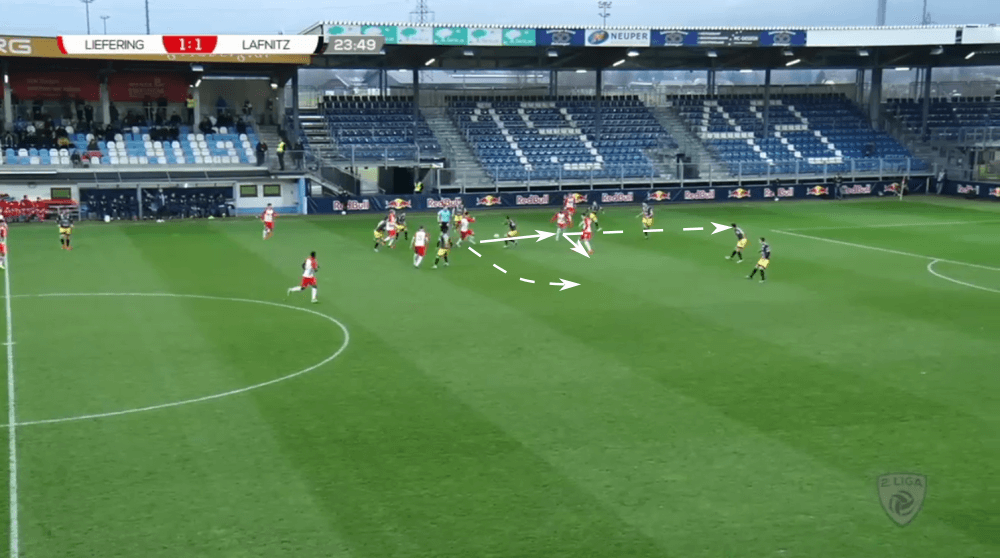
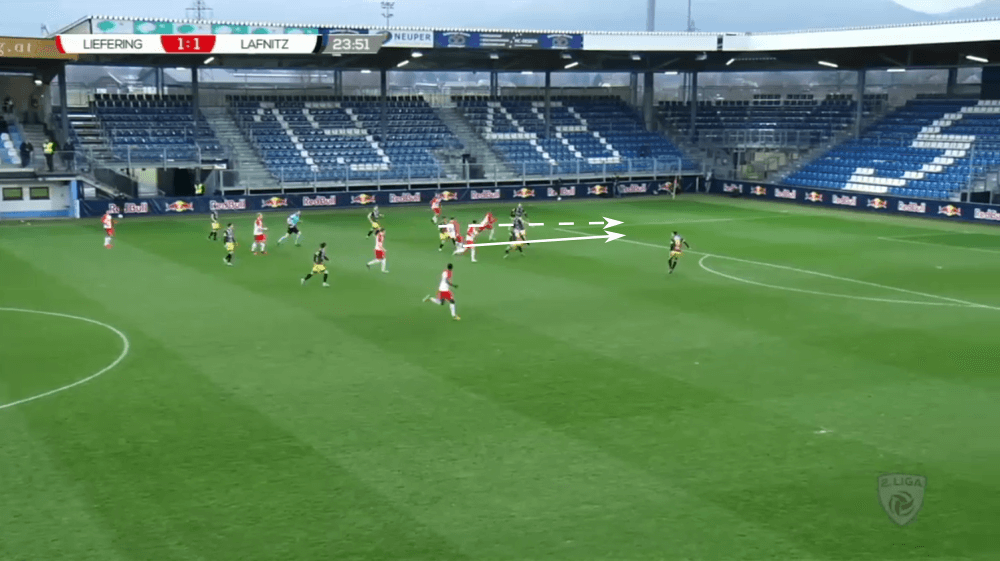
Also, when they enter the final third, usually the full-back on the side where the ball was progressed or where the ball is located in the final third has the freedom to push forward and support his teammates. The second full-back can either stay back near the two centre-backs (like in the first shot below) or also be positioned a bit higher to be in a good place to win the second ball after, for example, a cross (second image). Additionally, the central and most defensive midfielder acts differently whenever they progress the ball up the pitch. While in some situations he stays deeper in front of the centre-backs to be in a good position to stop counter-attack (first image), he also occasionally pushes forward. This depends on the scoreline and the positions of the opponents.
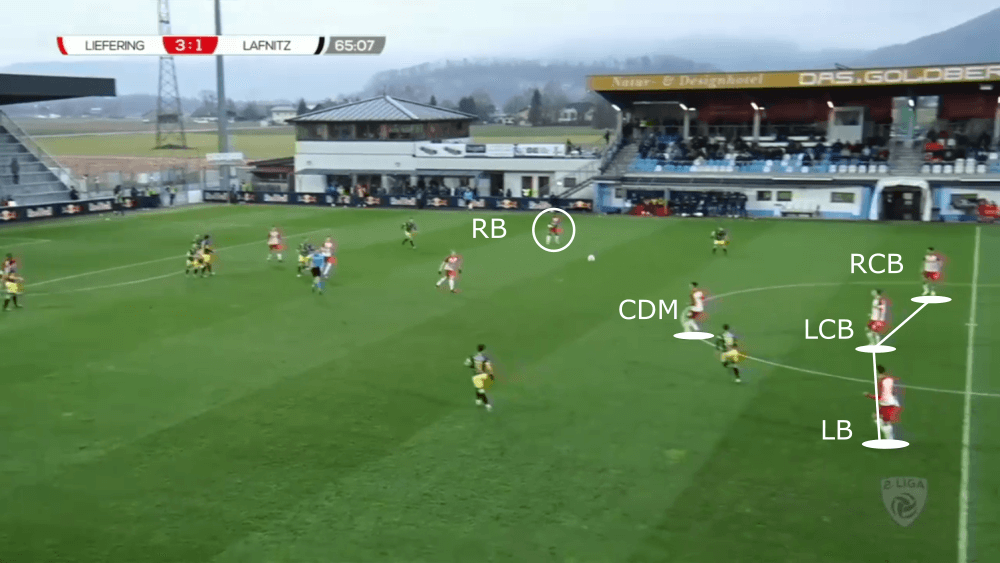
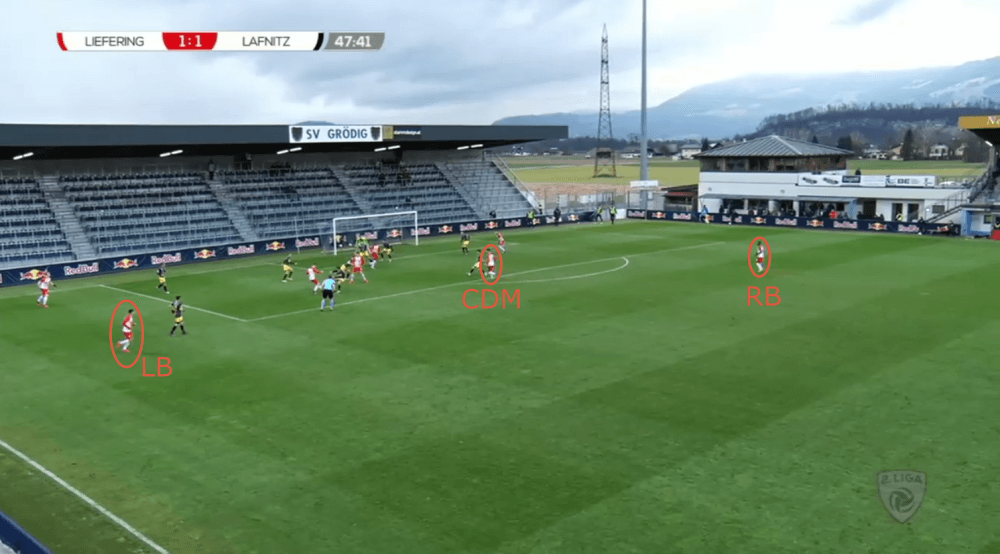
Active without the ball
Even though they try, as already mentioned, to mainly use short passes during the build-up, we can sometimes see long balls used as well by one of their deeper players, so they can immediately start the counter-pressing in a higher line. This is one of the tactics which is very similar to the ones of RB Salzburg.
However, when out of possession, Liefering often switch between a high-pressing (and counter-press when they have lost the ball) and sitting back in a lower block. Their formation and the positioning of the players doesn’t differ in these moments out of possession compared to the build-up as we can see below.
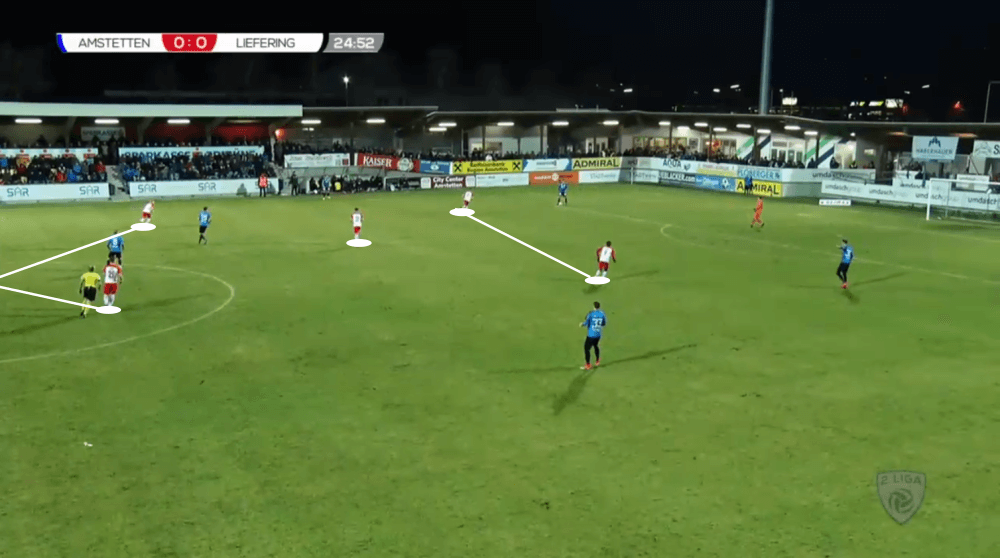
Their press is extremely variable as they don’t always use the same patterns. Nowadays, we often see games in Europe’s top leagues like the EPL, La Liga, Serie A, or the Bundesliga where the teams always use the same pattern for the press. One really popular one is, for example, to force the opposition to play to the wide areas where you then put pressure on them.
However, Svensson and his side use mainly two different ways of putting pressure on the opposition higher up the pitch. They either force them to the centre (first image below) where they then often have numerical superiority due to their four central orientated midfielders, or they use the aforementioned pattern by forcing the opposition on the wing and pressing in at them there (second shot). Note in the first shot how the left striker Prass uses a curved run to force the centre-back to the centre, while in the second situation two players put pressure on the ball carrier while the striker cuts off the option for a back pass.
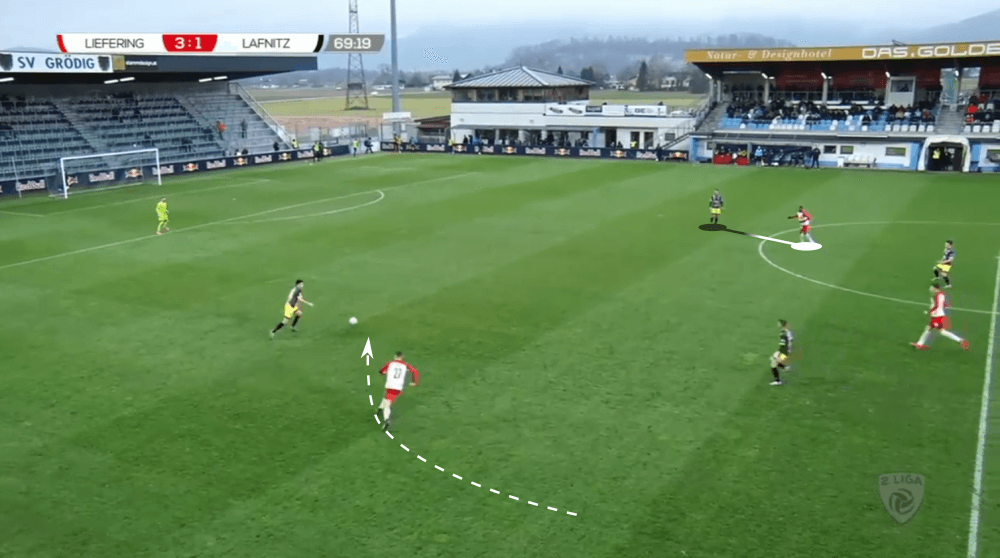
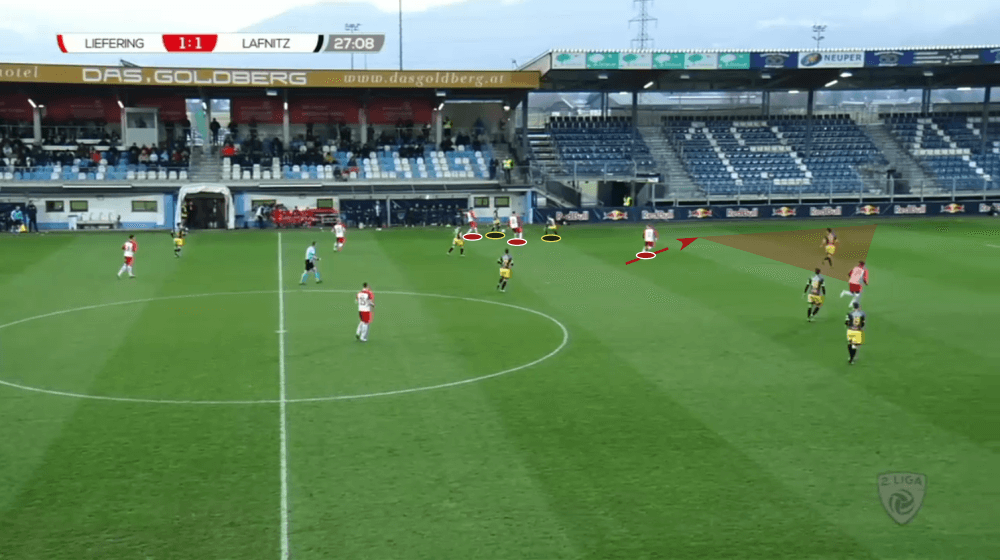
Of course, formations don’t tell you much about a team and are just like telephone numbers, as Manchester City’s coach Pep Guardiola once said, and without any further analysis they bring up no information about the tactics of a team. However, they can give you a certain hint where this team could be vulnerable. In Liefering’s case, the 4-3-1-2 already shows that we can expect them to be quite focused on the middle and in the first part of the tactical analysis when we looked at their build-up and progression of the ball, we saw that they are paying a lot of attention to the centre.
And that’s also the case out of possession. No matter if it’s during instances of putting pressure on the opposition higher up the pitch, or sitting back deeper, the players are positioned horizontally compact which gives away space in the wide areas which teams often try to exploit as we can see below. Even though it doesn’t work out properly in this scenario as Sučić reads the game and intercepts the switch, these long balls from one side or the centre to the other wing are an often-used way to progress the ball against Liefering. In the actual game, this pass wasn’t successful, but I just want to outline in the shot below how many players are in the centre, which gives the opposition a lot of space in the centre.
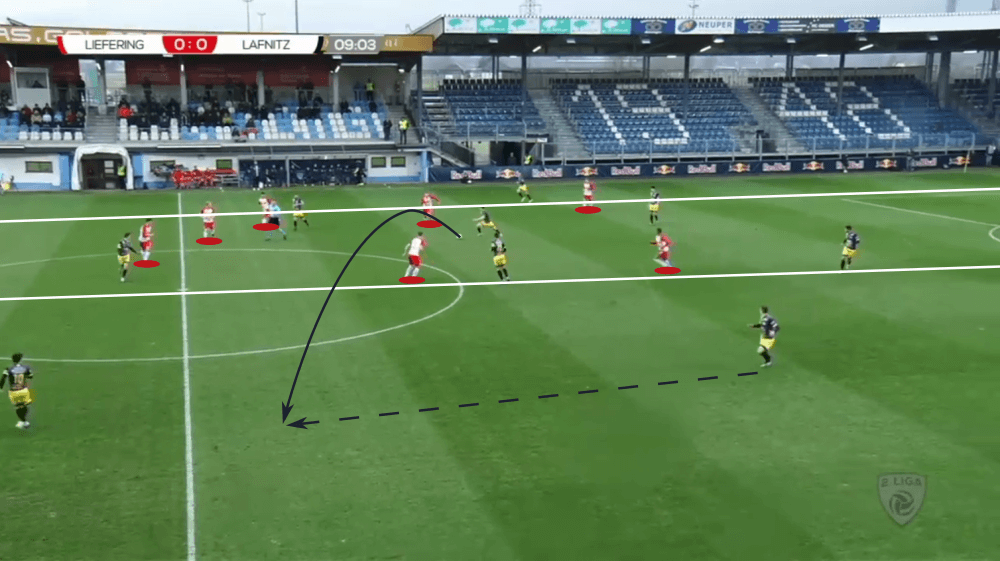
As already mentioned earlier in this tactical analysis, they don’t only press in at their opponents higher up the pitch, but also sometimes sit back to lure out the opposition. Again, they stay in their 4-3-1-2 system and are horizontally compact to have enough bodies in the centre. This can be perfectly seen in the example below.
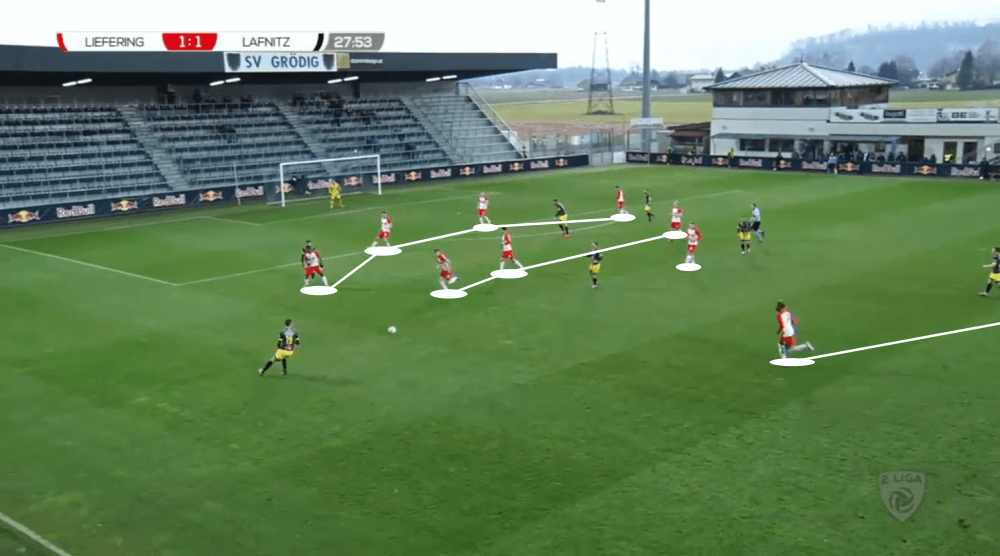
Counter-attacks
One of the reasons why they often sit back is to lure out the opposition which then opens up space for the counter-attacks. They have a PPDA (passes per defensive action) value of 7.34 which is slightly lower than the league average (7.86) and shows us that they don’t only use the high press and counter-press.
As soon as Svensson’s team can win the ball back, they try to get as quickly as possible forward to create a goalscoring opportunity. The behaviour in both moments of transition is a central part in the RB philosophy and therefore it’s not surprising that Liefering also love to hit the opposition on the counter-attack.
The first thing which catches your eye whenever you watch how Svensson’s players act during a counter-attack is how much they focus on the centre. The only two players who really have the wings as their main area of the pitch (both full-backs) are logically deeper during stages for winning the ball and due to that, are not involved in every counter-attack. Because of this, one of the central players would have to go wide to provide a passing option to the wing which they rarely do as they focus extremely on the centre during the counter-attack as we can see below. All players are in the centre and start vertical runs expect the one player on the left wing who doesn’t stay wide, but sprints diagonally into the middle as well.
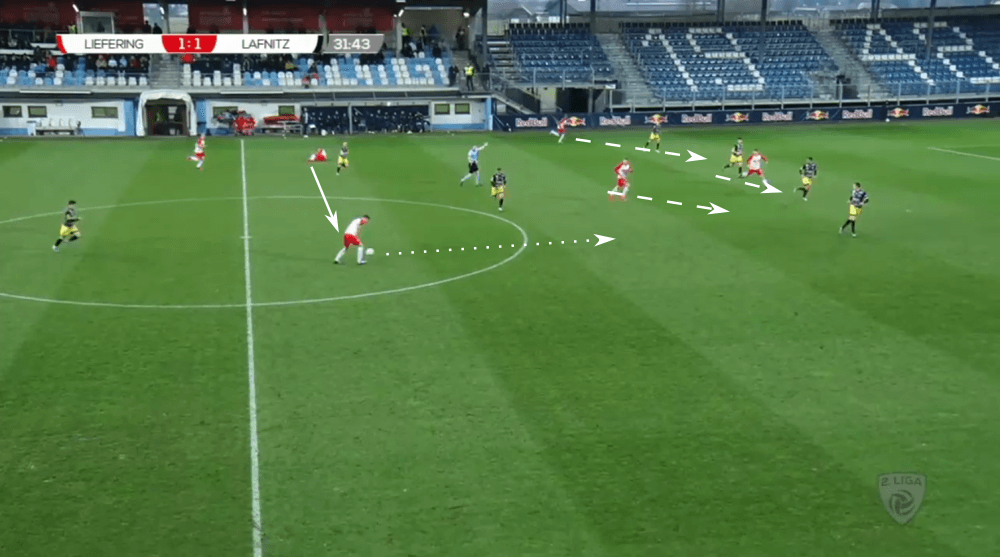
However, it is interesting to see that even when, for example, one of the strikers moves wide to stretch the pitch a bit during the counter-attack, they still prefer the central option. This is a logical (and typical, for RB teams) decision since you would have to go back into the centre to create something if the ball is played wide. Meanwhile, when you constantly look for the penetrating through pass in the centre, you will instantly create a goalscoring chance.
In the example below, Chukwubuike Adamu moves wide during the counter-attack, but still, Wallison goes for the central through pass towards Prass, but the keeper reads the game perfectly and comes out to intercept it.
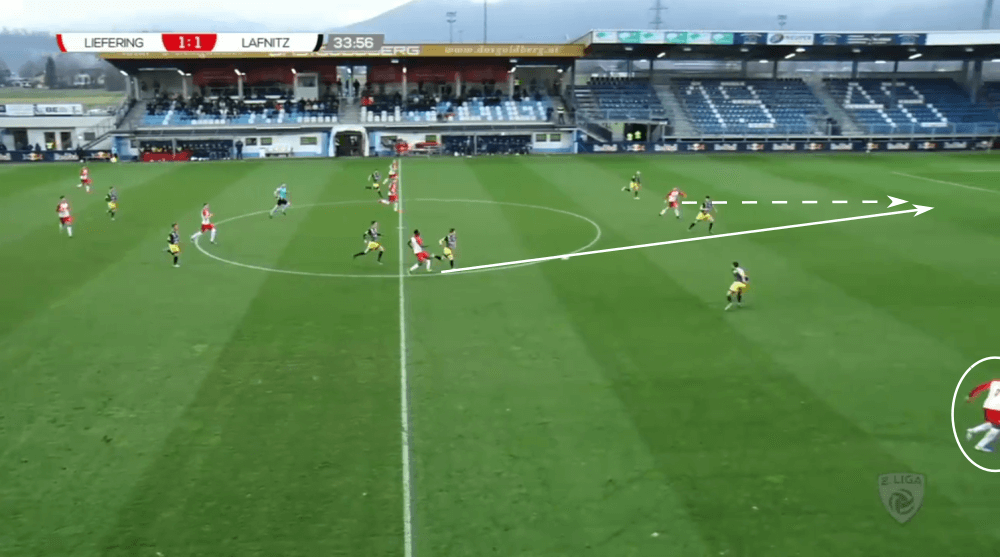
Another aspect of Liefering’s tactics that gets especially visible during the offensive transition is dribbling. Svensson encourages his players to dribble since the majority of the players have the technical abilities to go past several opponents by exploiting their pace. Considering this, it is no huge surprise that Liefering are the team with the highest number of dribbles per game in Austria’s second division, with 43.33. They use dribbles not only during the counter-attacks, but also in the periods of possession and the build-up respectively.
In the example below, Karim Adeyemi uses a dribble during a counter-attack to keep up the speed of the counter-attack. Adeyemi is officially now part of RB Salzburg’s squad since January 2020, due to Erling Haaland’s move to Dortmund and Takumi Minamino’s departure to Liverpool.
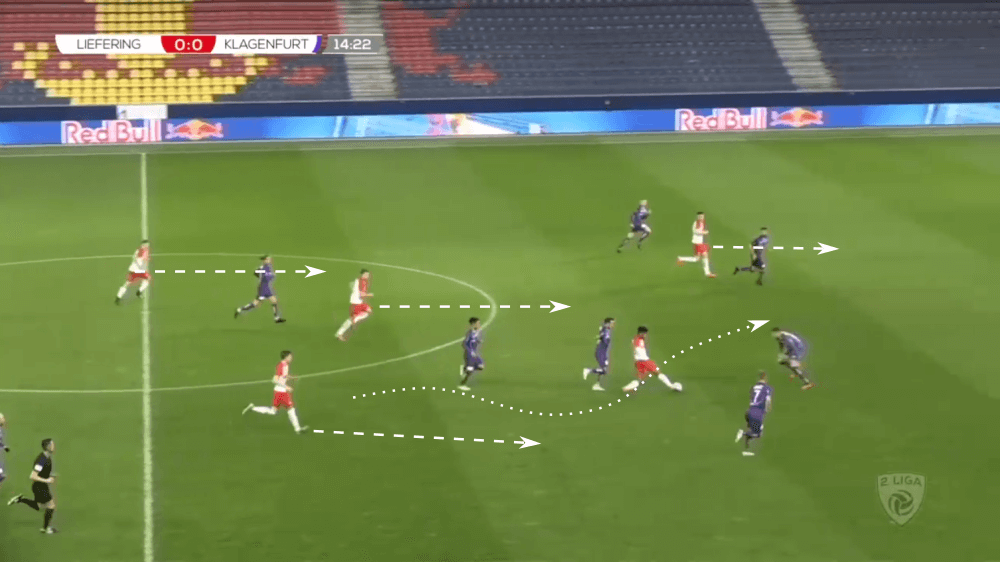
Conclusion
Svensson tries to stick with the basic principles of the RB philosophy and tactics as his team are incredibly strong in the offensive and defensive transition, and like to put pressure on their opponents high up the pitch. However, while RB Salzburg are the most dominant team of the Austrian Bundesliga and RB Leipzig are among the best teams of the Bundesliga, and though Liefering have the greatest talents of Austria’s second division, they clearly aren’t among the very best teams (currently 5th position). Due to that, they also have periods where they sit back deeper and lure the opposition out as they aren’t the favourites to win the match in every single game, like Salzburg and Leipzig are.
Considering this, it will be really interesting to see if Svensson takes over RB Salzburg within the upcoming years and then the question will be how different will they play since the Dane’s team would be the best of the league. And since Svensson is just 40 years old, who knows where his way goes and how his philosophy will develop when he takes over a different kind of club?





Comments